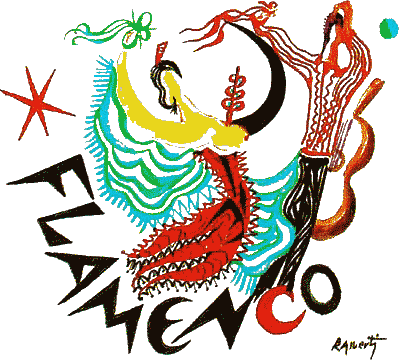
Welcome to the Flamenco/Latin American Dancing Page!Go to our Dance School Page! Salsa Verde Spending time in Spain can leave you with a passion for latin music and dance! Latin American Dance classes are running in Limerick - as part of Salsa Verde dance club. What follows here is a basic introduction to Flamenco and Latin American Dance, and some favourite links. For details of the class schedule and teachers go to Salsa Verde FlamencoFlamenco experienced a revival in the 80s and 90s. The impetus began at the end of the 70s with the innovations of the guitarist Paco de Lucia and the late singer, Cameron de la Isla. The roots of flamenco evolved in southern Spain from many sources: Morocco, Egypt, India, Pakistan, Greece and other parts of the Near and Far East. How they came together as flamenco is a source of great debate and obscurity, though most authorities believe the roots of the music were brought by gypsies arriving in the fifteenth century. It fused with elements Arab and Jewish music in the Andalucian mountains, where Jews, Muslims and 'pagan' gypsies had taken refuge from the forced conversions and clearances effected by the Catholic kings and church. The main flamenco centres and towns of gypsy and refugee origin, such as Alcala del Rio, Utrera, Jerez, and Cadiz, and the Triano barrio of Sevilla.Flamenco thrived, preserved and protected by the oral gradition of the gypsy clans. Its power, and the despair which it overcomes, has emerged from the precarious and vulnerable lives of a people surviving for centuries at the margins of society. It is essential for an artist to evoke a response, to know they are reaching deep into the emotional psyche of their audience. The may achieve the rare quality of 'duende' - total emotional communication with their audience. Flamenco thrives most in live performance. There is a classical repetoire of more than 60 flamenco songs (cantes) and dances ('danzas'). Flamenco songs often express pain and with a fierceness that turns emotion. Generally, the voice closely interacts with improvising guitar, the two inspiring each other, aided by the 'jaleo': the hand-clapping palmas, finger-snapping palillow and shouts from participants at certain points in the song. What is so visually devastating about flamenco dance is the physical and emotional control the dancer has over the body: the way the head is held, the tension of the torso, and the way it allows the shoulders to move, the shapes and angles of seemingly elongated arms, and the feet which move from toe to heel, heel to toe, creating rhythms. Flamenco dates back to about 1750 and, along with the music, moved from the streets and private parties into the cafe cantantes at the end of the nineteenth century. Women began to adopt the flamboyant 'hata de cola' - the long- trained dresses, cut high at the front ot expose their fast moving ankles and feet.
Joaquin Cortes Flamenco Links Latin American DanceA most exciting form of dancing comes from the Latin American countries. It is danced to music that has its origins in Africa and is vibrant, sensual and very rythmic. Cuban rythms have been taken and modified to give us the Latin dances danced in the "Ballroom." Five of these dances which have beenpopularised all over the world: Cha Cha, Rumba, Samba, Paso Doble and the Jive.Other dances which are danced popularly at the moment are Merengue, Salsa, Mambo and Lambada. Merengue is an erotic dance with a strong and accen tuated rhythm. Under a strong Afro-Cuban influence it developed to the form we know today. Salsa means 'sauce' (salsa picante). Salsa goes back to the traditional dance music of 'cuba' played by puertoricans in the ghettos of New York Salsa embraces elements of Rumba and Mambo, Afro- Cuban Jazz, Bossa Nova and Afro-American Soul or Latin Rock. Mambo is an Afro-Cuban style of music and originated in its best-known form in the same era as 'Big Band Jazz' (1930-to late 50s). Mambo was the first African-influenced rhythm of Cuba to enter into high society ballrooms and dance clubs. The Lambada, finally, is also a dance of Brazil. Links: |
 Home
HomeSalsa Verde Dance Club
 Links:
Links: